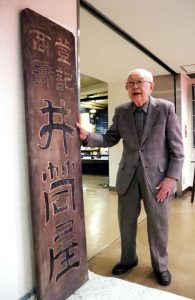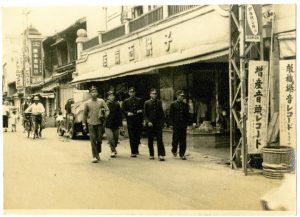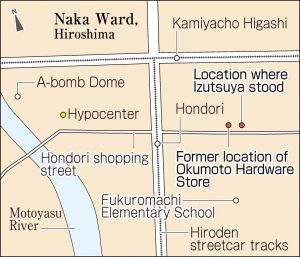Striving to fill voids in Hiroshima—Recreating cityscapes: Sign belonging to Izutsuya pharmacy, once located in Hondori shopping arcade, on display at history museum
Mar. 24, 2022
Reminiscent of life at shop of long-standing
by Rina Yuasa, Staff Writer
A sign belonging to a medicinal paste shop, in business on the Hondori shopping street until the closing days of World War II, exists today and was donated to the Hiroshima City Museum of History and Traditional Crafts, located in the city’s Minami Ward. The sign escaped the fires that arose after the atomic bombing because the drugstore, known as Izutsuya, had closed its doors shortly before the area was annihilated in the U.S. atomic bombing, with the owners having moved the business to a different location. This sign is useful for communicating the appearance of life around Hiroshima’s busiest shopping street before the atomic bombing.
The sign reads “Izutsuya—registered tradename.” The letters carved in the brown wooden sign are painted in gold paint and black ink. The sign, measuring 184 centimeters long and 49 centimeters wide, is heavy. It was found when Yasuaki Aratani, 63, a professor at Yokohama City University, was cleaning his parent’s home in Hiroshima’s Nishi Ward. Mr. Aratani, who lives in Yokohama City, donated the sign to the city museum in January this year.
Yayoi Maeno, chief curator at the museum, worked to identify where the drugstore had been located. Among the many photographs on the website of the Chugoku Shimbun’s “Striving to fill voids in Hiroshima,” she found one that showed ever so faintly wording that read “Izutsuya Medicinal Paste Store.” Next to the drugstore was the Okumoto Hardware Store. Hiroshi Okumoto, 91, a resident of Hiroshima’s Naka Ward, was born and raised in that spot. Ms. Maeno contacted Mr. Okumoto and, based on his account, she was able to confirm the location of the drugstore with some degree of confidence.
“Yeah, I remember what the shop was like,” said Mr. Okumoto in early March when visiting the museum and looking on with nostalgia at the Izutsuya sign. “The store had a narrow frontage, and about two-thirds of its left side was a raised tatami-floored seating area. The couple who owned the shop would provide medicinals to customers in that kind of relaxed atmosphere.” He said he remembers the couple mixing what appeared to be Chinese herbal powders into medicines.
In a list of members of the Hiroshima Chamber of Commerce and Industry issued in the early period of the Showa Era of Japanese history (1926–1989), there is mention that Izutsuya was founded in the Kanei Era (1624–1644). The Okumoto family was the owner of the building on Hondori. “When we received phone calls addressed to Izutsuya, we would call them and convey the message. We made a hole in the wall between our house and their store and put a string with a bell attached. When there was a phone call for them, we would ring the bell.” The late Taizo Sueda, who was the oldest son of the owner and the grandfather of Yokohama City University’s Mr. Aratani, was Mr. Okumoto’s English and homeroom teacher when he was a student at the former Shudo Junior High School.
The atomic bomb was dropped on Hiroshima on the morning of August 6, 1945. At that time, Mr. Okumoto was at the Hiroshima Army Ordnance Supply Depot, located in Hiroshima’s present-day Minami Ward, where he worked as a mobilized student. His house, located only 340 meters from the hypocenter, was completely destroyed by the fires that arose after the bombing. Six members of his family, including his parents and a sister, were killed in the bombing. He said that the Izutsuya shop had moved to the Koi area (now part of Hiroshima’s Nishi Ward) shortly before the bombing. According to the Shudo Junior High School historical account, Mr. Sueda experienced the atomic bombing when he was in a streetcar near the Fukuya Department Store and died on August 28.
Mr. Aratani said, “While alive, my mother did not tell me where on the Hondori shopping street the drugstore was located, or that my grandfather, an A-bomb victim, was an English teacher. I’m amazed we were able to find out so much about the appearance of the shop and its atmosphere at the time.”
The sign will be on display through March 27 in a special exhibit at the museum. However, during that period, the museum will be closed March 22-23.
(Originally published on March 24, 2022)










